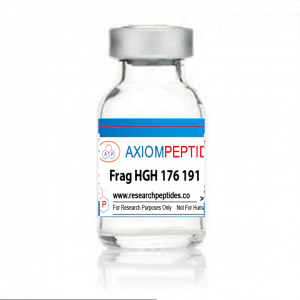Fragment 176-191
$49 Original price was: $49.$30Current price is: $30.
Residue Sequence: Tyr-Leu-Arg-Ile-Val-Gln-Cys-Arg-Ser-Val-Glu-Gly-Ser-Cys-Gly-Phe
Solubility: 100 µg/mL sterile diluent (distilled de-ionized water)
Molar Mass: 1815.08 g/mol
CAS Number: 221231-10-3
PubChem CID: 71300630
Molecular Formula: C78H123N23O23S2
MG: 2mg
Fragment 176-191
Growth Hormone peptide fragment 176-191, also referred to as HGH Frag 176-191, maybe a modified sort of amino acids 176-191 of the GH polypeptide. Investigators at Monash University discovered that the fat-reducing effects of GH appear to be controlled by a little region near one end of the expansion Hormone molecule. This region, which consists of amino acids 176-191, is a smaller amount than 10% of the entire size of the GH molecule and appears to possess no effect on growth or insulin resistance. It works by mimicking the way natural somatotropin regulates metabolism but without the adverse effects on blood glucose or growth that’s seen with unmodified somatotropin. Like somatotropin, the HGH fragment 176-191 stimulates lipolysis (the breakdown or destruction of fat) and inhibits lipogenesis (the transformation of nonfat food materials into body fat) both in laboratory testing and in animals and humans. Laboratory Tests and Fat Loss In laboratory tests on fat cells from rodents, pigs, dogs, and humans, the HGH fragment released fat specifically from obese fat cells but not from lean ones, reduced new fat accumulation altogether fat cells, enhanced the burning of fat. In rodents (rats and mice), HGH fragment reduced body fat in obese animals but, enhanced fat burning without changing food consumption or inducing growth (as it doesn’t increase IGF levels) or the other unwanted somatotropin effect. Research dosages of 500mcg of the HGH fragment 176-191 daily for 30 days did show a discount of body fat within the mid abdominal area in both obese, over-weight, and average built people. Fragment 176-191 as a lively HGH Truncated Peptide HGH fragment 176-191 is an analog of the expansion hormone-releasing factor (GRF) which signals the consequences of somatotropin. it’s a 15-mer peptide residue of the C-terminus of HGH to which tyrosine is added at the N-terminal end. This synthetically produced hormone is extremely common to weightlifters and bodybuilders due to a variety of physical benefits.
Studies claimed that it actually acts on the reduction of excessive adipose tissues like those within the abdominal area, increase in muscle mass, and enhances the lipid content of the body. These segments of the synthetic peptide HGH 176-191 are investigated for his or her in vivo effects in laboratory mice musculus. Research results have shown that HGH 176-191 has resulted in a short-period increase in blood sugar and a more sustained increase in plasma insulin, alongside other fragments like 172-191, 177-191 and 178-191. additionally, the researchers have suggested that the functionality of the peptide depends not only within the informational sequence but should even have the right physical configuration (Ng and Borstein 1978). Also, this fragment, being a neighborhood of high accessibility to proteases and also rich in proline, are demonstrated to affect the conformational change within the cytoplasmic domain of the band 3 of erythrocyte membrane protein by serving because of the hinge for the pivoting of the 2 subdomains.
This then suggests that such residue is critical in conformational changes be serving as sites for peripheral protein binding in some body cells (Low et al. 1984). In another study of Ng et al. (2000) on animal subjects, they acknowledged that a 500mcg dosage of the said hormone increased the lipolytic activity in adipose tissues without having negative influence within the blood sugar level. Furthermore, though it behaves sort of human somatotropin (HGH), it doesn’t cause hyperglycemia because it doesn’t compete with HGH receptors (Wu et al. 1993). due to such effects, researchers have suggested that it’d be used for the elimination of excess abdominal fat which may be a significant aspect of HIV-associated lipodystrophy. The (HGH fragment 176-191) exhibits the power to burn through stubborn fat, while increasing energy expenditure, muscle mass, and fat oxidation. All studies have pointed to the very fact that the fragment is an efficient treatment for obesity and fat loss, and far safer than its Human somatotropin counterpart.
Be the first to review “Fragment 176-191” Cancel reply
Related products
Peptide Hormones
Peptide Hormones
Peptide Hormones












Reviews
There are no reviews yet.